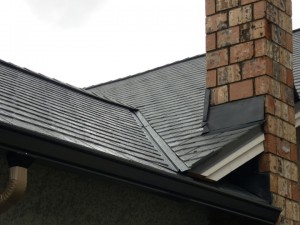Roof Ventilation and Insulation
April 29th, 2014
An adequate roof ventilation system is an absolute must when installing a new sloped-roofing system for longevity, conservation of energy and to maintain good air quality in your home.
Having a proper ventilation system is also a requirement from shingle manufacturers when it comes to material warranties as ensuring adequate ventilation and insulation is standard practice in the roofing industry.
Ventilation prevents and ameliorates the effects of ice damming and other effects of inclement weather. Ice damming results partially when warm attic air leaks from your home and meets cold exterior air; this meeting of hot and cold air causes condensation to form and during very cold weather the condensation can freeze. If your roof includes a balanced ventilation system, continuous airflow moves hot, moist attic air out of roof ventilators thereby preventing ice damming. Air is usually taken in at the soffit area and expelled near the roof peak via the exhaust.
When it comes to homes with vaulted and cathedral ceilings, a ridge vent system is installed. At each rafter cavity an exhaust is installed because these types of ceilings basically have several distinct attic spaces. Therefore, installing a single ventilator will not sufficiently remove attic air. Similarly, homes with attic living spaces, sometimes known as interrupted attic designs, should also include a ridge ventilation system.
With respect to insulation, it is important to know that many older homes were built with very little or sometimes no insulation at all. Unlike modern buildings, older houses may have been renovated multiple times, the result of which is varied insulation in walls and ceilings. This inconsistent application can contribute to the ice damming effects of poor ventilation. As such, insulation is also an important aspect of your new roof installation.
Properly sealing your roof starts with a comprehensive strategy of adequate ventilation and the installation of sufficient insulation. This improves the thermal efficiency of a home and can even save you in energy costs. A balanced ventilation and insulation system will improve the lifespan of your roof and as a side benefit, the air quality in a home is also often improved.
More specifically, air sealing requires that you first locate areas of your roof where you find air movement in the building’s envelope. Windows and doors, wall plugs, deficiencies in vapour barriers or a complete lack of vapour barriers, and other roof penetrations (even for roofing structures) are common areas of air movement. Ultimately, all roofing materials must be installed and inspected correctly to allow for proper ventilation according to manufacturer’s instructions. Areas with air leakage must be sealed in order to ensure the proper functioning of ventilation and insulation systems.
Many homeowners are unaware of the complexities of roof structures making it particularly important to work with a qualified, professional roofer. Proper installation of your roof system starts with quality materials and equally important is the ventilation and insulation application.




